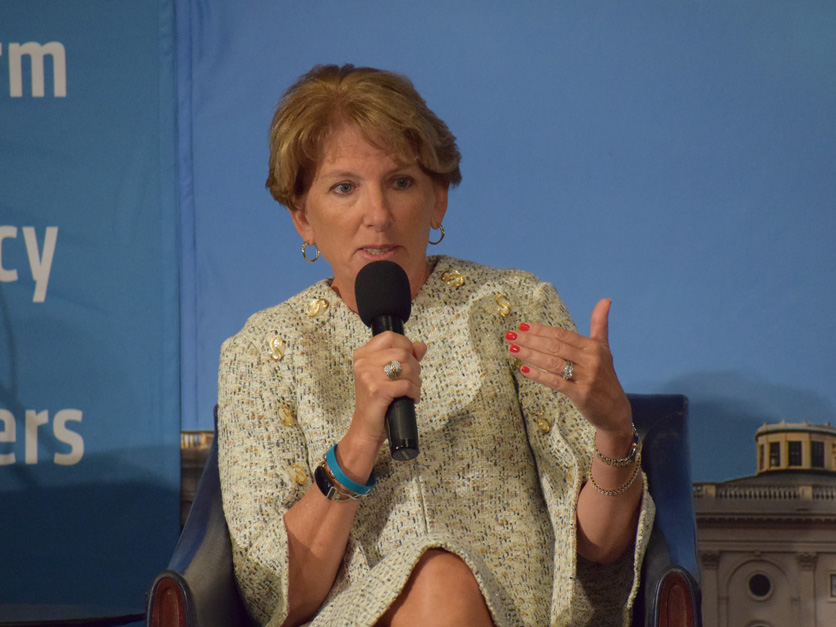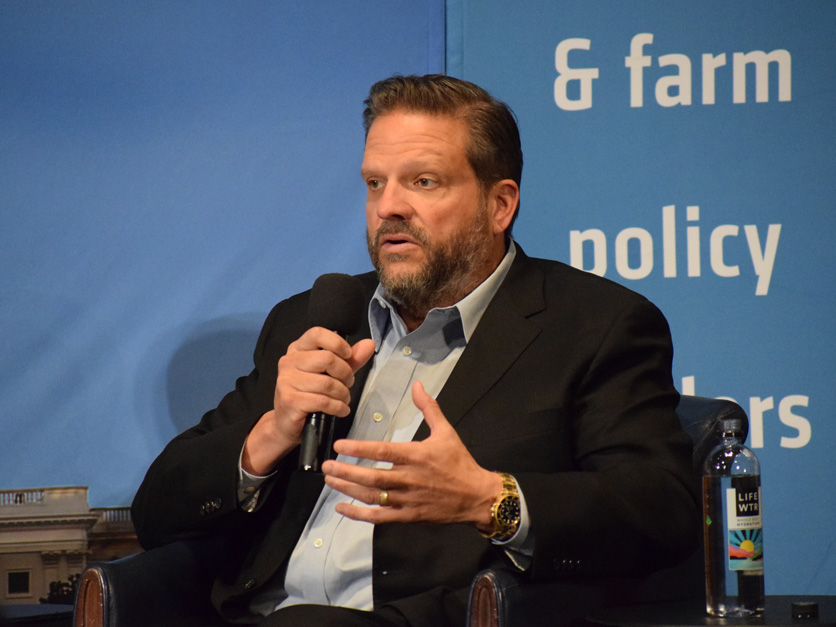Advocates for produce prescriptions and medically tailored meals are hoping to use funding from the farm bill and federal and private health plans to support the case that providing people with the right foods will improve health outcomes.
“There's no better time than in a post-COVID world, where people have a really different association between their health and the food they eat,” said Cathy Burns, CEO of the International Fresh Produce Association.
Speaking at the annual Agri-Pulse Ag and Food Policy Summit, Burns said she envisions a world where your “diagnosis is being treated by what's on your plate, not only what's in a pill.”
The first produce prescriptions (PRx) were funded in the 2014 farm bill and further expanded through the Gus Schumacher Nutrition Incentive Program of the 2018 farm bill. Up to 10% of the $250 million allocated over five years was earmarked for produce prescriptions.
The National Produce Prescription Collaborative, of which IFPA is a member, estimates that over 200 organizations administer PRx interventions. “A growing body of evidence, including 30+ studies in peer-reviewed scientific and economic journals in the past five years, suggests that PRx improves intake of fruits and vegetables, improve overall dietary quality, and importantly for clinical care, improve weight, blood pressure and lower Hemoglobin A1C among patients in poor cardiometabolic health,” NPPC said in a letter urging continued adoption of produce prescriptions.
 Cathy Burns, IFPA
Cathy Burns, IFPAGusNIP funded 108 pilot projects in 32 states to validate that an increase in fruits and vegetables can reduce body mass index (BMI), reduce weight, and improve blood sugar levels. Over 1,000 Medicare and Medicaid managed care plans also validate the data of the effectiveness of produce prescriptions, IFPA said.
“We already have proof that it is working across all demographics, all socio-economic levels,” Burns said.
Many of these initial studies evaluated the impact of produce prescriptions for as little as six to 12 months. Burns and the NPPC say more funding is needed to scale these projects for the long run.
“Data is king,” she said, adding those pilot projects need to have more time and participants need to see the true impact to put it on par with medical clinical trials that span multiple years.
There's an opportunity to complement pharmaceuticals with produce prescriptions, or medically tailored meals, with funds from Medicare, Medicaid, Veterans Affairs, Indian Health Services and private health care providers, Burns said. Produce prescriptions should be a covered health care benefit, just as insulin would be if it shows health care outcomes, she explained.
“From my perspective, the answer is not P-H-A-R-M, it’s on the F-A-R-M,” Burns said.
The White House continues working to expand the use of food as medicine.
Last week, the White House released an expanded nutrition policy platform that encourages states to use Medicaid funding, including Medicaid waivers, to implement innovative ways to pay health care providers to help their patients make healthy food choices. Such Medicaid waivers are already approved in California, Massachusetts, Oregon and North Carolina. Burns said other states should apply for these waivers to use them for expansion of produce prescriptions.
The White House also suggested health insurance companies should consider expanding coverage of nutrition services and have doctors discuss with patients the importance of nutrition and physical activity.
The platform says health insurance companies “should also consider partnering with retailers and independent grocers to make healthy food, like fruits and vegetables, more available at a lower cost through efforts such as produce prescription programs.” Hospitals and health care providers also have a role to play; the White House encouraged them to work with local groups and community-based organizations to offer medically tailored meals to reduce hospital admissions.
CalOptima, a county-organized health system that administers health insurance programs for low-income children, adults, seniors and people with disabilities in Orange County, California, reached out to SunTerra Produce to become a supplier of new medically tailored meal programs for those with chronic health challenges.
Steve Brazeel, the founder of SunTerra Produce, said the COVID-19 pandemic provided new partnerships and lessons on how to expand the delivery of fresh fruits and vegetables, offering new ways to expand market opportunities for farmers that also have consumer health benefits.
For the last several months, SunTerra delivered thousands of boxes every single week to members’ homes as a benefit of their health insurance policy through the CalOptima partnership.
Brazeel said in-house registered dietitians tailor boxes to address chronic medical conditions. “We’re seeing phenomenal results in terms of improvement in health and reduction of hospitalizations and doctor visits,” he said.
 Steve Brazeel, SunTerra Produce
Steve Brazeel, SunTerra ProduceInstacart, the leading grocery technology company, launched its own Instacart Health division in 2022. The division's Foods as Medicine pillar provides tools to health care providers and their patients to promote health. Organizations can fund category-specific spending through their Fresh Funds program, which allows recipients to shop eligible categories on Instacart, such as fresh and frozen produce.
Sarah Mastrorocco, vice president and general manager of Instacart Health, said several challenges have prevented health care providers from effectively adopting food-as-medicine programs at scale.
Instacart Health announced several new partnerships as part of the latest White House event that look to expand the research evaluating the impacts of using food as medicine. They will partner with Boston Children’s Hospital and at least four other major health care providers across the U.S. to create virtual food pharmacies and other food-as-medicine interventions using Instacart Health products, making it easier for providers to prescribe food just as they would medications and scale-up use.
Instacart will also launch four new studies with researchers at Mount Sinai Hospital, University of Kentucky, University at Buffalo, the Stanford Cancer Institute, Food for Health Equity Lab at Stanford Medicine, and the University of California, San Francisco’s Helen Diller Family Comprehensive Cancer Center to study the impact of nutrition security interventions and food-as-medicine services on different patient groups, including individuals living with low incomes.
Alison Gustafson, director of the Food as Health Alliance and a professor at the University of Kentucky, plans to launch two grocery prescription pilot programs to study the impact of food-as-medicine interventions on nutrition security, glycemic control and blood pressure in pregnant women with gestational diabetes or Type 2 diabetes and adults with hypertension or type 2 diabetes who also use Medicaid, Instacart shared.
Don’t miss a beat! It’s easy to sign up for a FREE month of Agri-Pulse news! For the latest on what’s happening in Washington, D.C. and around the country in agriculture, just click here.
Josh Trautwein, co-founder and CEO of About Fresh, said his organization's Fresh Connect debit card can allow providers to limit the purchase of only those foods that meet specific health needs, such as a low-sugar yogurt for a diabetic, but not a yogurt with chocolate chips.
Trautwein said the federal Centers for Medicare and Medicaid Services, which oversees those programs, should be thinking about billing codes and the allowable use of state Medicare and Medicaid funds. Current guidance caps enrollment in prescription produce programs to six months, which limits the long-term ability to gauge success.
In addition, the National Produce Prescription Collaborative said, “Through the collective experience of the NPPC in administering and researching PRx, we can attest that there will be times when a 6-month PRx program sufficiently stabilizes a patient’s health, and they will be able to continue their new dietary habits when the program ends. However, there will also be a high proportion of patients who will need additional time and access to healthier, nutrient-dense options to shift clinical endpoints, which often require monitoring and treatment beyond 6 months.”
Trautwein said the pilot projects and continued investment helps build the evidence of why food “is not a temporary solution, not as an add-on to health care, but a deeply embedded feature of how we deliver health care.”
If the momentum continues, Burns believes the industry has the opportunity to change the trajectory of human health, while also helping support produce farmers create new and lasting markets for their products. “I think that’s worth getting up for in the morning,” she said.
For more news, visit www.Agri-Pulse.com.


